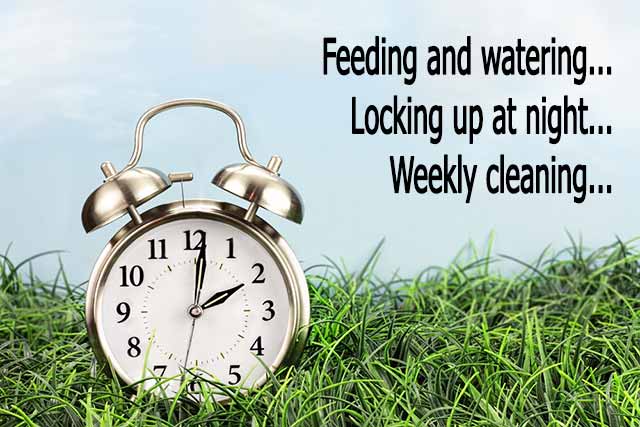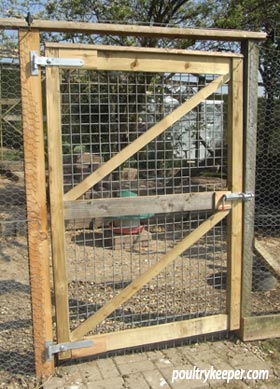Keeping a few chickens in the back yard really is quite straight forward; however there are some things to consider in order to get the right sort of birds for your situation and to keep them in the best possible health to get the most enjoyment out of keeping them.
This page hopes to get you thinking about the types of chickens and their requirements.
Choosing a breed
There are quite literally hundreds of different breeds of chicken to choose from and out of these, many have slightly different requirements.
Some breeds of chicken come only as Large Fowl, and others are also available as Bantams which are a smaller version that look the same. The Orpington for example is available in both large and bantam sizes but the Cochin is only available as large fowl.
There are a handful of ‘True Bantams’ where there is no large fowl equivalent. Examples of these are Dutch Bantams, Japanese Bantams and the popular Pekin Bantam.
Bantams tend to be quite flighty whereas the heavy breeds of large fowl often cannot fly more than a few inches off the ground. Orpingtons for example won’t usually roost very high due to their huge size and will usually just huddle on the floor of the coop.
Every breed is slightly different in the amount of eggs they lay. Typically hens that have been bred for exhibition purposes do not lay as well as utility hens. Bantams of course lay smaller eggs which some people say they prefer for taste.
Hybrids
 Hybrids are chickens that have been created by crossing pure breeds. They are typically crossed to make good layers (the hybrid to the right can lay 280 to 300 eggs!), coloured eggs or attractive hens. Some can be very attractive and they are all generally very hardy. Hybrids are produced in larger numbers that pure breeds and most of the crosses used make the males a different colour as day old chicks so that only females can be raised, therefore reducing costs by about half. A typical hybrid hen will cost you around £15 compare to £25 to £30 for a typical pure breed hen.
Hybrids are chickens that have been created by crossing pure breeds. They are typically crossed to make good layers (the hybrid to the right can lay 280 to 300 eggs!), coloured eggs or attractive hens. Some can be very attractive and they are all generally very hardy. Hybrids are produced in larger numbers that pure breeds and most of the crosses used make the males a different colour as day old chicks so that only females can be raised, therefore reducing costs by about half. A typical hybrid hen will cost you around £15 compare to £25 to £30 for a typical pure breed hen.
Hybrids are a good choice if eggs are one of your priorities although if you think you might like to hatch some eggs, remember hybrid hens do not breed true – you would need the original pure breeds to cross again in order to create more of the same thing so whilst you can hatch their eggs, you may want to consider a few pure breeds for this purpose or consider buying in eggs to hatch.
Free Range
You will of course need a chicken coop but also a secure run or area that is predator proof. A question that people always ask me is “How big should their run be?” I always say “as big as possible within reason.” Even 2 chickens kept in a 2 meter run will soon turn it to mud and get bored (which can introduce vices such as feather pecking and egg eating) but I always believe that it’s fine to provide a small run like this if you can let them out for a few hours each day to free range while you are around. This will give them a chance to forage, supplement their diet and reduce boredom.
Once chickens have settled into their new house, they will go back to it to roost every night so you can let them out in the late afternoon, knowing they will come back to roost at night keeping everyone happy! Some houses and runs have handles or wheels that make them easy to move onto fresh ground which is not only good to prevent a build up of worm eggs and disease but also provides them with a little fresh grass to graze.
Keeping Chickens in the Garden
If you have a ‘nice’ garden that you don’t want spoilt, it’s usually a sensible idea to limit their foraging. Chickens scratch at the ground, make dust baths in the dry soil, leave muck wherever they go and destroy tender young plants. If you can plant in pots, this will help and fencing off part of the garden is usually a good choice to keep them out if you have tender or precious plants. Chickens with feathered feet scratch less and bantams can clear a 6 foot fence if they want to. Heavy breeds of large fowl can be kept out with a knee high fence or box hedge. If you want to stop a bird from flying then you can clip one wing (not both).
So you have decided on the breed that’s right for you and your circumstances. Next, you will need to think about keeping them secure from predators in a suitable chicken house and chicken run – click on a link to go to that page!








Hi there,
This website is fantastic and I shall be sharing!
Thinking of getting 3 or 4 chickens. We have a large area at the bottom of our garden but it is covered with slate chips. Would this be ok and we could hose it down or would we need wood chips? We have a grasses area too but ideally want to keep the turf looking good!
Many thanks
Vickie x
Slate should be OK as long as there aren’t sharp edges that could cut their feet. As it gets messy, hose it down.
A great plug for box hedges. Never heard of them being used for chickens before but I love the idea. Can I steal it for a post of my own please?
Sure, go for it Julian. We use fruit trees (from Ashridge…) planted around the field to provide the hens with some cover. The roots need protecting with some netting (which soon disappears into the grass thanks to the activity of earth worms). Chickens having originated from jungle fowl appreciate some cover from trees and feel much more confident wandering further from the coop when they have this cover. Birds of prey will take smaller chickens and all poultry still have a fear of things flying in the sky – I hear my cock birds giving a warning ‘Brrrrrrr’ when something dangerous flies over and the hens scurry for cover.
Hi there, I’m hoping to keep a couple of birds. We have a back garden which is pebbles without grass. Would this still be ok for chickens?
Yes, that’s fine, you can provide them with regular fresh greens.
Hi this site is really good, I have a large garden and I am planning on getting some hens, I have an area in mind but the wall between my garden and the neighbours is only around 4ft high and worried the hens will fly over their, also do I need to keep them in a caged area when I’m not at home incase they get out area i put them in(wire roof) and sorry need advise on a friendly but good laying hen as I have kids
Hybrids are usually the best option for beginners – they will lay regularly and are vaccinated and generally no trouble.
They will need to have a wing clipped and I think you would need to look at increasing the size of the 4ft fence a little to stop them from wandering next door.
Yes, while you are out, it is a good idea to keep them in a secure area due to foxes but many people will take a chance during the day if the garden is relatively secure, there are people around (perhaps neighbours / dogs etc) and there aren’t many foxes around but it’s always a risk.
Hello, I love this website, it is very useful!
I am interested in getting some bantam Orpington hens. I would have them as pets and to show and would sell their eggs ust to make a bit of money. I was just wondering how big a coop would have to be for bantam orpingtons. We don’t have much space, and have a dog so they wouldn’t be able to be completely free range. It might sound strange but I also wanted to know if you can walk chickens!
Thanks 🙂
As big as possible is the answer but in reality a minimum of a meter square per bantam would suffice providing they get lots of greens and a substrate such as hardwood chip or sand that they can scratch through to keep themselves busy, preventing boredom.
No, they won’t walk with you unfortunately but maybe you could let them out an hour before dark with the dog shut in to let them have a bit of a scratch around?